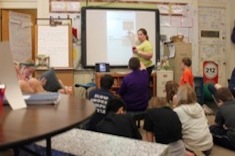Our classroom was quiet and dark. The students who had started our minilesson by being spread out and relaxed had pulled closer to the screen and were leaning in. I glanced around the room and looked at these large fifth-grade bodies and smiled. What had mesmerized them so? This video. In the video students learned about a project overseas where a group of people funded the construction of a school in Bangladesh.
The students sat with notebooks open on their laps. A quote from the clip was written in their notebooks: “There is no ‘them,’ only facets of us,” by John Green. We watched the video, I defined facets, and then we wrote. What does that mean? What did this video make them think? Did it inspire them in any way? After a short writing reflection, we talked.
When my students gather around our meeting area at the carpet for a minilesson, we typically share a text. Picture books are the perfect length of reading for a minilesson. Articles, too, are often shared. Last year I began to introduce another piece to our minilessons: videos. The discussion tends to be rich.
Wonderopolis is a terrific website that pairs text and videos. I’ve used it often during reading minilessons and in small groups. It was in these lessons that I began to see the power of a video during a minilesson. Videos pull in all the learners in my classroom, but especially my visual learners. They are typically entranced by the screen and focus intently on what is being shared. I also like how videos level the lesson for all of my learners. My students with reading disabilities can share the same “text” as my other students and then discuss the clip in groups. My students with attention issues seem calmer and more focused when getting the chance to watch a short video clip. For all of these reasons—and many more—I have added several videos to our minilessons.
Finding videos to use in the classroom is akin to stumbling upon a great idea when you weren’t expecting it. I often see commercials with a great theme and look it up online to share in my reading class the next day. (Nike commercials for the Olympics on Greatness are a terrific example of that.) At any day on Facebook, friends share uplifting videos they have found, and those work their way into our classroom. When teaching a specific unit, like Digital Literacy, I search on Google for videos that might fit. There is no end to the ways I have come across videos. They remind me of my search for mentor sentences; once I began looking for them, they were everywhere. Here are just a few we used this year:
In exploring digital citizenship, we watched this video. It really helped the students wrap their minds around their digital footprint, since many didn’t believe they had one yet.
After watching it, we also viewed this video as a reminder to put down the technology once in a while.
We paired this video with Daniel Beaty’s picture book Knock Knock: My Dad’s Dream for Me to show the power of our stories.
To show the power of small acts of kindness, we watch this video.
To spread the message of making our lives count, we have watched this message from Kid President.
Finally, we’ve used videos to help everyone aspire to have meaningful lives. I asked the students what they believe greatness is and they wrote a paragraph. Then, I showed this video, and we revisited what we wrote and edited as needed.
Videos integrated into minilessons capture my students’ interests. Some of our best discussions on reading, writing, and our choices have happened as a result of a quick clip we have watched together. Just as shared texts build our class community, these videos have shaped our stories.



